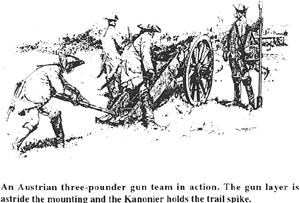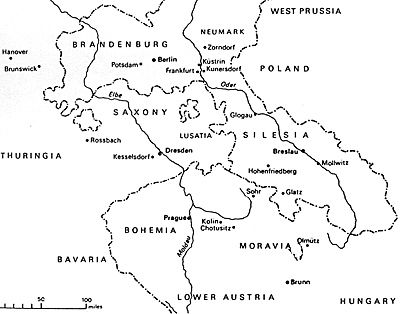 Mollwitz was Frederick the Great's first battle and there he gave little indication that he would become the greatest military commander of his time. That he allowed himself to be caught off guard by the Austrian offensive in the spring of 1741 and to be driven from the field along with most of his cavalry made a most unpromising beginning. Mollwitz is interesting on the tactical level in that it revealed the shortcomings of the Prussian cavalry but enhanced the reputation of the infantry. The battle showed that it was possible for infantry to be the determinant of victory when it stood firm while supporting cavalry routed.
Mollwitz was Frederick the Great's first battle and there he gave little indication that he would become the greatest military commander of his time. That he allowed himself to be caught off guard by the Austrian offensive in the spring of 1741 and to be driven from the field along with most of his cavalry made a most unpromising beginning. Mollwitz is interesting on the tactical level in that it revealed the shortcomings of the Prussian cavalry but enhanced the reputation of the infantry. The battle showed that it was possible for infantry to be the determinant of victory when it stood firm while supporting cavalry routed.
Frederick also stumbled upon the idea of a rectangular battle formation, wherein grenadier battalions would fill the gap between the first two lines of battle, facing outward to secure each flank of the army. This occurred as a result of an error in deployment at the start of the battle, but proved to be the crucial factor in the Prussian victory. Frederick quickly learned the value of this formation and used it in some form or another in the rest of his battles.
The Historical Background
Frederick's Prussian army invaded Silesia in December 1740 and had swept most of the Austrian forces out of the province by the end of January 1741. A few small garrisons held out in the cities of Glogau in the north and Brieg and Neisse in the south, but these were effectively blockaded by Prussian detachments. As winter reached its peak, the Prussian army was garrisoned in numerous towns and villages along a 200 mile front stretching from the Glogau/Liegnitz area in the north to Jagerndorf/Troppau in the south near the Moravian-Hungarian border. Silesia had proved easy to invade from the north via Brandenburg, and should theoretically have been easy to defend against an Austrian attack from Bohemia or Moravia to the south and west. The Riesengebirge Mountains formed a natural barrier along this frontier and a sufficient force to hold the mountain passes might have kept the Austrians out.
Frederick, however, had not counted on two factors: the resolve of Austria and Maria Theresa to hold Silesia and the existence of swarms of Croat and Magyar irregulars who made life miserable for Prussian convoys, patrols, couriers and garrisons on the Silesian side of the mountains. This screen of irregulars hampered Prussian communications and intelligence gathering and very nearly caught Frederick off guard when the Austrians marched back into Silesia in March 1741.
 Austrian Counter-attack in 1741
Austrian Counter-attack in 1741
Maria Theresa had no intention of allowing Frederick to occuppy Silesia and permanently detach it from the Hapsburg lands. Austria had a population ten times that of Prussia and with the financial backing of England, had the means to raise an army to deal with Frederick. By the end of March, Field Marshal Neipperg had assembled an army of 20,000 men at Olmutz in Moravia.
His lieutenant, general Maximilian von Browne,urged him to attack while the Prussians were scattered around Silesia in their winter quarters. Neipperg was no ball of fire when it came to initiative and enterprise, but eventually he agreed to a plan to relieve Neisse and Brieg in quick succession. This would place the Austrian army astride Frederick's supply lines which flowed through the Silesian capital of Breslau and on down the Oder River to Ohlau, near Brieg. It would also divide Frederick's half of the army, quartered aound Schweidnitz, from Schwerin's command south of Neisse, near Jagerndorf.
Neipperg had almost reached Neisse on April 4 before Frederick was even aware of his movement. A week earlier, Frederick sensed that his forces were too close to the mountain passes and vulnerable to attack, but General Schwerin convinced him that the forward positions were secure and talked him out of the idea. Never again would Frederick allow a subordinate to talk him out of his natural instinct. Now it was a race to see who could reach the Prussian supply depot at Ohlau on the Oder River. The king immediately called off the blockade actions at Neisse and Brieg in order to concentrate his forces. He also order Prince Leopold Dessauer, in command of the troops at Glogau, to assault that fortress and join Frederick as soon as possible.
A small river, called the Neisse, flows from the town of the same name towards the Oder River near Brieg. Frederick ordered all detachments to meet him halfway down this stream at Sorge, so that they could cross over to the west bank and beat the Austrians to Ohlau. On April 4, Neipperg could only manage five miles through the muck and sludge that passed for roads, while Frederick's command managed 18 miles. Nevertheless, on April 5 the advance cavalry guard of Neipperg's army (11 regiments of cavalry) blocked the river crossing at Sorge. The race continued-the Prussians moving up the east bank of the Neisse and the Austrians keeping up as best they could on the west bank.
On April 8, the Prussians finally crossed the Neisse at Michelau and Lowen and hoped to advance on Ohlau and prevent the Austrians from capturing Breslau. The two armies were on a collision course; both knew it, but neither commander had a clear idea of where the other one was. Austrian cavalry continued to block the road to Ohlau at Grottkau, forcing the Prussians to make camp a few miles southeast of Mollwitz. Frederick's army now included 31 battalions of infantry (17,000 men), 34 squadrons of cavalry (4,000 horse) , and 60 guns or a total of 22,000 men. Neipperg, meanwhile, quartered his troops south of Mollwitz and after a day's rest, planned to march on Brieg a few short miles away. His forces included 16 battalions of Infantry (9,000) and 13 cavalry regiments (9,000) and only 19 guns.
Battle of Mollwitz: April 10, 1741
-
Background and Austrian Counter-Attack
The Action Begins
The Austrian Cavalry Charge
Momentum Swings to the Prussians
Order of Battle and Wargaming Mollwitz
Back to Seven Years War Asso. Journal Vol. VI No. 1 Table of Contents
Back to Seven Years War Asso. Journal List of Issues
Back to Master Magazine List
© Copyright 1992 by James J. Mitchell
This article appears in MagWeb.com (Magazine Web) on the Internet World Wide Web.
Other articles from military history and related magazines are available at http://www.magweb.com